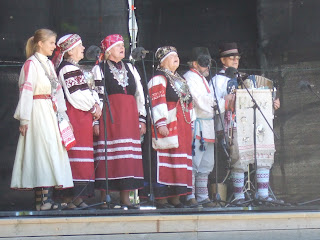 It's late spring in Estonia, usually sunny and warm and very green--and the many festivals found indoors during the cold winter months are now to be found outdoors, often in the neighborhoods. One such was Kalamaja Days, an area of older traditional wooden houses (and two of our favorite cafes), one of the most grass-roots of local festivals. It's a combination of various music and dance groups, homemade food, activities for kids, garage sales to raise money for the children's museum, and other such things. A vaguely Middle Eastern/Spanish dance group was one of the more popular to watch, as we munched home-made goodies.
It's late spring in Estonia, usually sunny and warm and very green--and the many festivals found indoors during the cold winter months are now to be found outdoors, often in the neighborhoods. One such was Kalamaja Days, an area of older traditional wooden houses (and two of our favorite cafes), one of the most grass-roots of local festivals. It's a combination of various music and dance groups, homemade food, activities for kids, garage sales to raise money for the children's museum, and other such things. A vaguely Middle Eastern/Spanish dance group was one of the more popular to watch, as we munched home-made goodies.But, as usual, we also couldn't overlook the opportunity for a one-day road trip (by bus), to the old (1200's) and charming town of Vijande--complete with the ruins of a huge old castle and church complex, and a variety of local art museums, including "The Museum of Naive Art" (what seems to be "folk" art), as seen in the painting (below right) of an Estonian wedding taking place in the forest (rather than in a church--weddings didn't move into churches until the Middle Ages, though we often believe they have always been a religious ceremony).
 Spring here is often a time of strong breezes, occasional storms, and dramatic clouds and light, as seen in the photo below taken from our bus window on the way back towards Tallinn.
Spring here is often a time of strong breezes, occasional storms, and dramatic clouds and light, as seen in the photo below taken from our bus window on the way back towards Tallinn.Here in Tallinn we've been enjoying Old Tallinn days. This included a climb up the many steps inside St. Olav Church's tower--for a couple of generations during the Middle Ages, the tallest human-made building in the world (!). From the top, we had some impressive views of the Vanalinn (Old Town), including the many church towers stretched across the area below. See the photo below right for an example (the multi-domed Alexander Nevsky Cathedral is the church in the middle).
Among the scores of free events during the festival, we particularly liked the Hungarian "circus" group (more a pantomime/puppet group with music). Their work was based on wit and creativity and whimsey, and delighted both the grown-ups and the small children (who plunked themselves all over the edge of the low stage to make sure they didn't miss anything).
 But, while Barbara was busy much of the weekend at an end-of-the-year conference her department has holding, I wandered about to the different "cultural" events, including a series of different folk-dance groups (as seen in the photo to the left). Some were from nearby countries, but most were from different regions of Estonia, each with their particular style of traditional dress and dance steps.
But, while Barbara was busy much of the weekend at an end-of-the-year conference her department has holding, I wandered about to the different "cultural" events, including a series of different folk-dance groups (as seen in the photo to the left). Some were from nearby countries, but most were from different regions of Estonia, each with their particular style of traditional dress and dance steps.I also enjoyed the various singing groups, including the Seto women (accompanied by men on the accordian) from southeast Estonia. An unexpected treat was an informal "food booth" set up by a large Uzbeki family (from Uzbekistan, one of the former Soviet central Asian republics) who were cooking up some traditional pilaf dishes with meats and veggies, with homemade flat bread!
In a small hillside park, one local arts group (there seem to be a myriad of small local arts and music groups in Tallin) had created paper maiche figures (larger than life) of some of their favorite 20th century Estonian heroes, one of whom is the first president of Estonia in "re-independence" (post-Soviet) times, Lennart Meri, seen in the photo below (the guy with the orange face). In the description of the piece, the artist sees him as someone who could "fly" (the figure is horizontal, with arms outstretched like wings), who embodied people's hopes at a very hopeful yet potentially perilous time (I think of Egypt as I write this).

I thought of a tapestry piece Barbara and I had seen a couple of days before (photo below), a scene from the national Estonian epic-myth, "The Kalevipoeg" (son of Kalev) (similar in purpose to Finland's "Kalevela" to the north). In many ways, of course, Meri and the epic heroes are very different--yet in embodying the possibility of a national identity and purpose, there are some similarities that might resonate with Estonians even today.

Some of that spirit may be seen in the photo below of the Estonian flag flying from the top of Toompea tower, on the hill where the national legislature meets.


And, to finish up this entry, I include a photo of Barbara at the celebratory dinner concluding her department's conference. This is one of the last official gatherings in connection with her work here at Tallinn University, and so was a special time for her. But she will write about our concluding days in a later post.
All for now! Bruce
All for now! Bruce




No comments:
Post a Comment